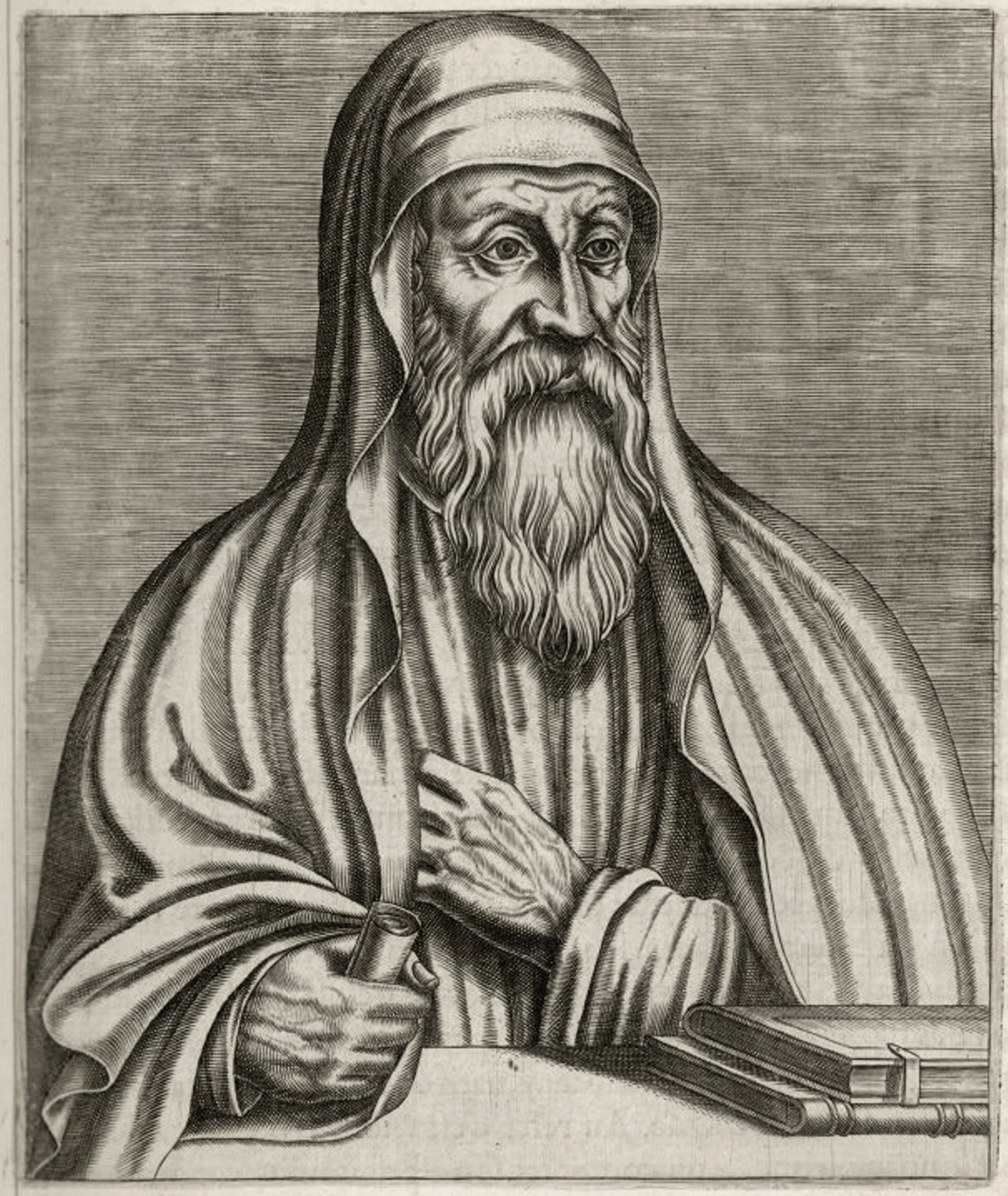
The Hexapla of Psalms
Felix Albrecht
December 14, 2021
The Hexapla (Ἑξαπλᾶ) was an ancient synopsis of the Old Testament in six columns, created by the early Christian scholar Origen of Alexandria (185–254 CE)[i] during the years 235–245 CE in Caesarea.[ii] Bernard de Montfaucon assumed that the whole work comprised more than 50 huge volumes and was never copied.[iii] The original is considered to be lost by the time of the Arab invasion of Caesarea in 638 CE.

Origen, portrait by Guillaume Chaudière (1584).The first column (a) of the Hexapla offered the Hebrew text, the second column (b), called the Secunda, a Greek transcription of the vocalised Hebrew text. The other four columns contained the Greek versions of Aquila (αʹ), Symmachus (σʹ), Origen’s slightly revised Septuagint version (οἱ οʹ), and the version of Theodotion (θʹ).
The fifth column (e) offered the Septuagint version received by Origen and revised later on by him (therefore sometimes also called Origenic recension): In case of variation between the copies of the Septuagint, Origen chose the readings that matched the Hebrew most consistently. In order to get the text in alignment with the Hebrew, Origen adapted the word order, if necessary. He also revised the proper names. The layout of the Hexapla looked like this:
|
a |
b |
c |
d |
e |
f |
|
Hebrew |
Secunda |
Aquila |
Symmachus |
Septuagint |
Theodotion |
|
|
ἑβρʹ |
αʹ |
σʹ |
οἱ οʹ |
θʹ |
In the case of Psalms, Origen used – beside the four Greek versions of αʹ σʹ οʹ θʹ – two extra versions, called fifth “Quinta” and sixth “Sexta” version (cf. Origenes, De Quinta et Sexta).[iv] Eusebius mentions even a seventh “Septima” version.[v] According to Epiphanius, the Hexapla of Psalms contained two additional columns, resulting in a synopsis of eight columns, called Octapla (Ὀκταπλᾶ).[vi]
However, we do not know if Origen included these extra versions in columns (no fragments of a copy in this format are extant) or in the form of marginal notes in the last two columns (e, f) as the so-called Mercati Psalter (Ra 1098) suggests. Apart from two small fragments (Ra 113, f. 7v; Ra 271, p. III), the latter is one of two fragments of the Hexapla of Psalms that have survived in columnar format, both are palimpsests and both are cropped: Ra 2005 (7th century CE, see on this manuscript Benjamin Kantor) is a heavily trimmed leaf that shows four fragmentary columns: Secunda, Aquila, Symmachus, and the Septuagint. Ra 1098 (10th century CE) is the most important fragment of the Hexapla. It provides five columns of selected Psalms that are part of a Psalter Catena. The Hebrew column is not preserved in this manuscript. Marginal notes in the last two columns indicate that two additional sources have been incorporated into it, which have been identified with Theodotion (marginal notes to column e) and with the Sexta (marginal notes to column f). All this leads to the conclusion, that Ra 1098 seems to represent either a reduced copy of the Octapla of Psalms (which contained the eight columns while the last two columns were added as marginal notes to colums e and f), or the outlook of the original Hexapla of Psalms. Mercati followed the idea that Ra 1098 was indeed representing the Hexapla of Psalms in its original layout ([Hebrew], Secunda, Aquila, Symmachus, Septuagint, Quinta).[vii] There were no additional columns, but marginal notes of two additional versions (Theodotion and Sexta). The (reconstructed) layout of Ra 1098 looks like this:
|
a |
b |
c |
d |
e |
f |
|
Hebrew |
Secunda |
Aquila |
Symmachus |
Septuagint (+ θʹ in the margins) |
Quinta (+ ϛʹ in the margins) |
|
|
ἑβρʹ |
αʹ |
σʹ |
οἱ οʹ |
εʹ |
Scholars who have studied Ra 1098 and its tradition (like Mercati, Venetz and Caloz) came to the following results:[viii]
-
Column f of the Mercati Psalter contains the Quinta version, not Theodotion.
-
Column e (Septuagint) is enriched with Theodotion readings (if differing from the Septuagint readings).
-
Column f (Quinta) is enriched with Sexta readings (if differing from the Quinta readings).
-
According to Mercati (and confirmed by Venetz, p. 85) Theodoret misidentified column f with Theodotion and quoted these readings as θʹ-readings, so that the tradition depending on Theodoret repeated these false θʹ-readings, which are actually Quinta readings.
-
Furthermore, the sigla of σʹ (Symmachus) and ϛʹ (Sexta) were often confused in the transmission of hexaplaric readings.
The Hexaplaric recension
Apart from the Hexapla as a synopsis, Origen began to produce a recension of the Septuagint text of Psalms (and the other books of the Septuagint). This endeavour was continued and further developed by his successors, Eusebius and Pamphilus. For example, we know from the colophons of the hexaplaric manuscripts (recently studied by Peter J. Gentry) that Pamphilus and Eusebius added readings from the Three in the margins. In this Hexaplaric recension, Origen probably applied the text-critical signs of the Alexandrian scholar Aristarchus. Illustrious examples of this recension are for instance Ra 922 (Ezechiel) and Ra G (Octateuch).[ix] Origen’s aim was to create a critical text by harmonizing the quantitative and qualitative differences: a plus of the Hebrew compared to the Septuagint was supplemented from the alternative versions, marked with an asterisk. A plus of the Septuagint compared to the Hebrew was marked with an obelus (for this practice in the Psalter, cf. Origenes, De asterisco et obelo).[x] If the plus contained more than one word, the end was marked with a metobelus.
The Syrohexapla
The Hexaplaric recension was distributed separately and further edited. In the year 616 CE, Paul of Tella prepared a translation into Syriac, the so-called Syrohexapla, in which readings of the alternative versions were incorporated as marginal notes. In case of Psalms, its Greek Vorlage was not an early version of the Hexaplaric recension, but an advanced one which exhibits influence from the Antiochene tradition as Rob Hiebert has shown.[xi] Our main witness of the Syrohexapla of Psalms is Codex Ambrosianus C 313 inf. (8th century CE).[xii]
The Göttingen Hexapla Database of Psalms
Next to the Syrohexapla, the testimonies of the Church Fathers such as Theodoret of Cyrrhus and Catena manuscripts like Ra 190, Ra 1133, Ra 1134, Ra 1140 and Ra 1175 are the main sources for the so-called Hexaplaric readings of Psalms. These readings or fragments of the Hexapla were finally collected and edited by Frederick Field in 1875.[xiii] All these fragments and additional material, discovered since, are collected in the Göttingen Hexapla Database of Psalms. Since we find readings of the Quinta, Sexta, and of “Others” in the manuscript tradition, the Göttingen database follows Field’s distinction in nine different categories:
|
a |
b |
c |
d |
e |
f |
g |
h |
i |
|
Hebrew |
Secunda |
Aquila |
Symmachus |
Septuagint |
Quinta |
Sexta |
Theodotion |
Other |
|
|
ἑβρʹ |
αʹ |
σʹ |
οἱ οʹ |
εʹ |
ϛʹ |
θʹ |
ἄλλος |
[i] Origen was born around 185 CE (cf. Eusebius, Historia ecclesiastica VI,2,2.12, implying that Origen was 16 in the tenth year of Septimius Severus), and died around 254 CE (cf. Eusebius, Historia ecclesiastica VII,1, stating that Origen died before he reached the age of 70).
[ii] Cf. P.J. Gentry, "Origen’s Hexapla," in: A. Salvesen/T.M. Law (eds.): The Oxford Handbook of the Septuagint, Oxford 2021, 553–71; F. Albrecht, "Hexapla of Origen," in: Encyclopedia of the Bible and Its Reception 11, Berlin et al. 2015, 1000–02; A. Salvesen (ed.), Origen’s Hexapla and Fragments, TSAJ 58, Tübingen 1998.
[iii] F. Field (ed.), Origenis Hexaplorum quae supersunt, sive veterum interpretum Graecorum in totum Vetus Testamentum fragmenta vol. 1–2, Oxford 1875, here: vol. 1, xcix. Eusebius and Pamphilus struggled to preserve Origen’s Library. The Hexapla may not have survived 350 CE (Peter J. Gentry, personal communication).
[iv] F.X. Risch, Origenes, De Quinta et Sexta, in: C. Bandt, et al. (eds.), Die Prologtexte zu den Psalmen von Origenes und Eusebius (TU 183), Berlin et al. 2018, 71–75.
[v] Eusebius, Historia ecclesiastica VI,3: ἔν γε μὴν τοῖς Ἑξαπλοῖς τῶν Ψαλμῶν μετὰ τὰς ἐπισήμους τέσσαρας ἐκδόσεις οὐ μόνον πέμπτην, ἀλλὰ καὶ ἕκτην καὶ ἑβδόμην παραθεὶς ἑρμηνείαν […].
[vi] Epiphanius, De mensuris et ponderibus 529–31: ἐὰν δὲ καὶ ἡ πέμπτη καὶ ἡ ἕκτη ἑρμηνεία συναφθῶσιν ἀκολούθως τούτοις ὀκταπλᾶ καλεῖται. On the Octapla see also A. Rahlfs (ed.), Psalmi cum Odis, Göttingen 1931, 60 (§ 6.8).
[vii] G. Mercati (ed.), Psalterii hexapli reliquiae, Codices ex ecclesiasticis Italiae Bybliothecis delecti phototypice expressi 8, Rome 1958–65.
[viii] Cf. H.-J. Venetz, Die Quinta des Psalteriums. Ein Beitrag zur Septuaginta- und Hexaplaforschung (Publications de l’Institut de recherche et d'histoire des textes. Collection Massorah I,2), Hildesheim 1974; M. Caloz, Étude sur la LXX origénienne du Psautier. Les relations entre les leçons des Psaumes du manuscrit Coislin 44, les fragments des Hexaples et le texte du Psautier gallican (OBO 19), Freiburg et al. 1978; F. Albrecht, Report on the Göttingen Septuagint, in: Textus 29 (2020), 201–20, here: 214–16.
[ix] Cf. P.J. Gentry, "Origen’s Hexapla," in: A. Salvesen/T.M. Law (eds.): The Oxford Handbook of the Septuagint, Oxford 2021, 565–66.
[x] B. Villani, Origenes, De asterisco et obelo, in: C. Bandt, et al. (eds.), Die Prologtexte zu den Psalmen von Origenes und Eusebius (TU 183), Berlin et al. 2018, 76-83.
[xi] Cf. R.J.V. Hiebert, The “Syrohexaplaric” Psalter (SCSt 27), Atlanta 1989.
[xii] A. M. Ceriani (ed.), Codex Syro-Hexaplaris Ambrosianus. Photolithographice editus curante et adnotante, Monumenta sacra et profana ex codicibus praesertim bibliotheca Ambrosianae 7, Milan 1874. The Syrohexapla of Psalms will be included into the Göttingen Hexapla Database of Psalms within the next year.
[xiii] F. Field (ed.), Origenis Hexaplorum quae supersunt, sive veterum interpretum Graecorum in totum Vetus Testamentum fragmenta vol. 1–2, Oxford 1875. A new edition of all the material is in preparation by our Project Partner, “The Hexapla Institute”.
by Bradley Marsh, June 30, 2025
by Felix Albrecht, May 31, 2025
by Kyle Young, April 30, 2025
by Ippolita Giannotta, March 31, 2025
by Jonathan Groß, February 28, 2025
by Malte Rosenau, January 31, 2025
by Ippolita Giannotta, December 16, 2024